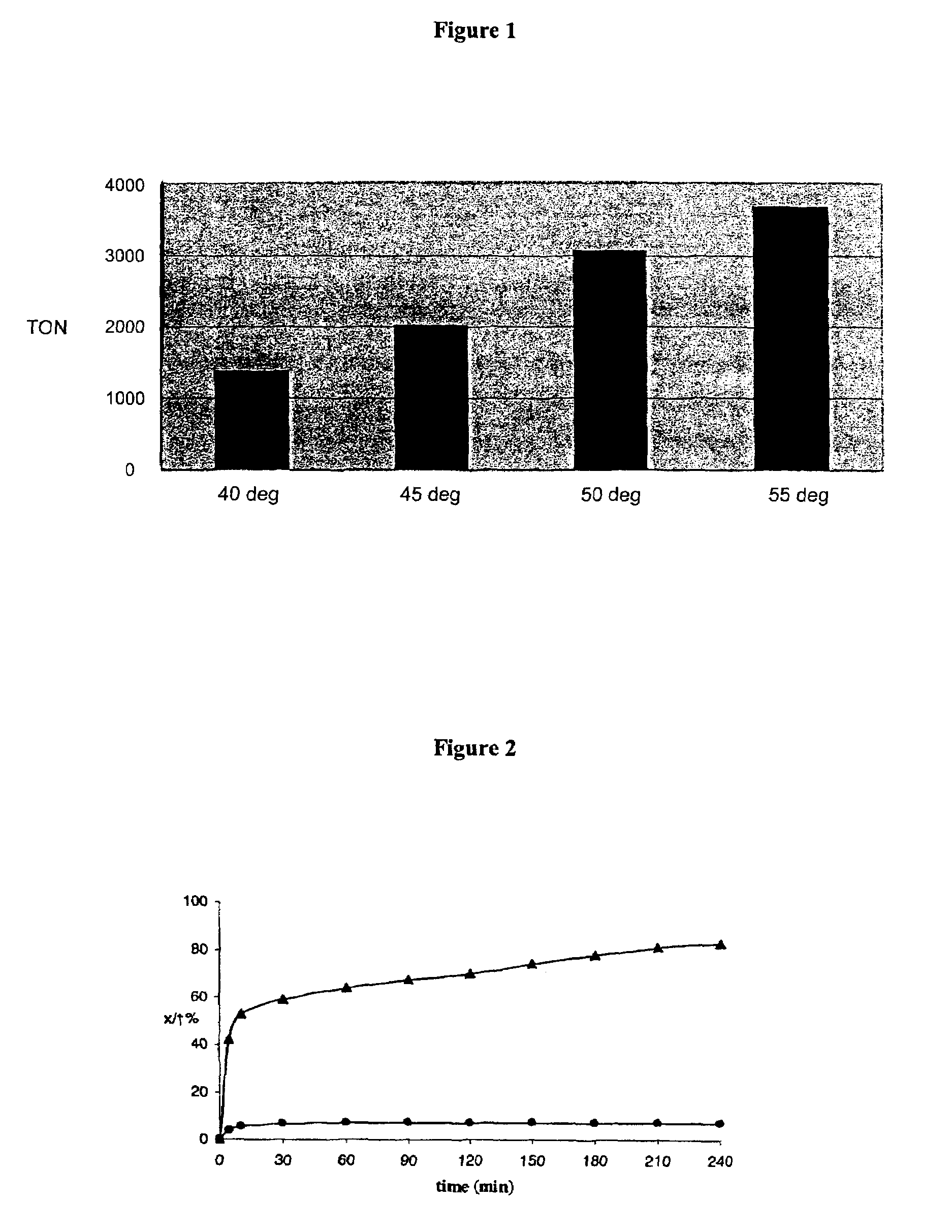Use of a phosphorus containing ligand and a cyclic organic ligand in a transition metal compound
a technology of organic ligands and transition metals, which is applied in the direction of organic compounds/hydrides/coordination complexes, catalysts, catalytic reactions, etc., can solve the problems of difficult preparation, high cost, and high cost of the first generation catalys
- Summary
- Abstract
- Description
- Claims
- Application Information
AI Technical Summary
Benefits of technology
Problems solved by technology
Method used
Image
Examples
example 1
Preparation of Complex (12)
[0114]
[0115]In a 50 mL round-bottom flask was added Ru(PPh3)3Cl2 (1.0 g, 1.04 mmol) and 1,1-diphenyl-2-propyn-1-ol (330 mg, 1.59 mmol) followed by degassed tetrahydrofuran (80 mL). The mixture was refluxed for 2 h and then the solvent was removed under reduced pressure. Cyclohexylphoban (ca. 3.1 mixture of [3.3.1] and [4.2.1] isomers, 672 mg, 3 mmol) in CH2Cl2 (20 mL) was added, and the mixture stirred for 24 h. After such time the solvent was removed and the residue taken up in hexane. The solid thus formed was sonicated for 10 minutes and stirred for 1 hour then filtered to give the desired complex (12).
[0116]31P(1H) NMR (121 MHz, C6D6): δ=22.0 (bs); 1H NMR (300 MHz, C6D6) δ=8.25 (s, 1H), 7.80-6.75 (m, 9H), 2.80 (s, 4H, PCH of Phoban), 2.26-0.40 (m, 46H, Phoban H).
[0117]Single crystals suitable for X-ray diffraction were obtained by recrystallization from evaporation of an ether solution. A crystal structure was obtained (below): C43H60Cl2P2Ru, Mr=810.82...
example 2
Metathesis Using Complex (12) in the Ethenolysis of Methyl Oleate to 1-Decene And 9-Methyldecenoate
[0119]Methyl oleate (99%) was purchased from Aldrich and passed through a short (2 cm) pad of alumina before use. In a 50 mL stainless-steel autoclave fitted with dip-tube for sampling was charged methyl oleate (12 g, 40.0 mmol). Tetradecane (2.5 g, internal standard) was added and the catalyst (12) of example 1 (0.010 mmol) was weighed and transferred into a Schlenk flask under argon. Toluene (5 mL, degassed) was added to the Schlenk flask and an aliquot (1 mL) of this stock solution was transferred to the autoclave. The autoclave was pressurized (4-20 bar (400 to 2000 kPa) of ethylene) and heated via computerized temperature controller to the desired temperature. Samples were taken at regular intervals using a dip-tube apparatus, and analyzed by GC with an MDN column.
[0120]The results are set forth in FIG. 1 which shows the productive turnover obtained using catalyst (12) (S / C=10 000...
example 3
Metathesis Using Complex (12) in the Self-Metathesis of 1-Decene
[0121]A 250 mL three-necked round bottom flask was fitted with a reflux condenser, thermometer and septum. A needle was inserted through the septum and connected to a gas supply via a needle valve to ensure a slow and steady stream of argon through the reaction solution. 1-Decene (24 mL, 0.127 mol) was added to the reaction vessel and the reaction was heated to 65° C. The catalyst (12) of example 1 (11.0 mg, 0.014 mmol) was weighed into a custom-made aluminum weighing tray and added to the reaction mixture. Samples were taken at regular intervals via syringe through the septum. Samples were analysed by GC with a Pona column.
[0122]The results are set forth in FIG. 2 which shows the % conversion obtained using catalyst (12) at 65 degree C.
[0123]It will be appreciated that catalyst (12) was easy to prepare from well accessible, stable and essentially non-toxic starting materials and the catalyst can be isolated and stored....
PUM
| Property | Measurement | Unit |
|---|---|---|
| pressure | aaaaa | aaaaa |
| ring structure | aaaaa | aaaaa |
| structure | aaaaa | aaaaa |
Abstract
Description
Claims
Application Information
 Login to View More
Login to View More - R&D
- Intellectual Property
- Life Sciences
- Materials
- Tech Scout
- Unparalleled Data Quality
- Higher Quality Content
- 60% Fewer Hallucinations
Browse by: Latest US Patents, China's latest patents, Technical Efficacy Thesaurus, Application Domain, Technology Topic, Popular Technical Reports.
© 2025 PatSnap. All rights reserved.Legal|Privacy policy|Modern Slavery Act Transparency Statement|Sitemap|About US| Contact US: help@patsnap.com



